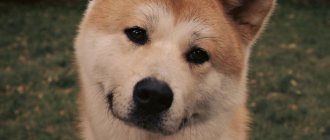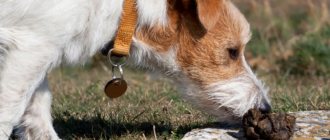This symbol appeared in our lives relatively recently. With the advent of email, we began to use the @ dog . Of course, its official name is completely different - commercial at . But do you know why it is this way, and what connection does a typographic symbol have with an animal? Probably few people have the answer. Let's find out more about this interesting sign, especially since it has its own interesting story.
♥ ON TOPIC: Americano coffee: why is it called that if it was invented in Italy.
History of the @ symbol
The exact origin of this symbol remains a mystery. The most traditional hypothesis says that the sign appeared in the Middle Ages as a contraction of the preposition ad (to, on, at, at). At the same time, the letters a and d merged. But relatively recently another version appeared. In the letters of Florentine merchants, a phrase was found about “the price of one @.” Scientists decided that we could be talking about a standard amphora, as a unit of volume. And later the sign was found in Iberian writing. This people settled on the territory of modern Spain about 5 thousand years ago. The symbol @ among the Iberians meant a special measure of weight and volume, arroba. In Spain in the Middle Ages it was about 11.5 kg. The word itself is derived from the Arabic ar-rub or "quarter" (a quarter of one hundred pounds). And one of the first mentions of the @ symbol was found in an Aragonese manuscript dating back to 1448.
Signs similar to the “dog” were found in Russian books of the 16th-17th centuries and even on the title page of the Code of Laws of Ivan the Terrible. But in this case it is worth talking about the letter “az” decorated with a curl, corresponding to a unit in the Cyrillic number system.
But English accounting helped popularize this symbol. There, the @ symbol began to be used as a simple replacement for the preposition at. And phrases like 5 apples at 1 dollar began to appear. And when typewriters appeared, the much-needed symbol was also found on the keyboard, and over time it migrated from there to the computer keyboard.
♥ BY TOPIC: 50 best optical illusions.
How to print?
The dog icon on the keyboard is located in such a way that it is almost impossible to find it by accident. In addition, it is not present in the Russian layout, since it is not needed there. After all, it is simply not used by Russians in their native speech and writing. In the English layout of the standard keyboard, @ is on key 2. How to type the “dog” icon? It’s very simple - hold down the Shift key and press 2 of the top numeric keypad. This does not work on other layouts. If @ is really necessary, you can copy it from any email address. There is another way to add a “dog” icon - open the menu for inserting special characters in a text editor, for example, Microsoft Word. Finding what you are looking for is not difficult; in the same window you can set a keyboard shortcut that will make it possible to type @ in the future.
How did the dog @ appear in e-mail?
The official date of the appearance of e-mail is 1971. But programmer Ray Tomlinson needed a symbol that would stand between the user name and the host name. This sign should be comfortable and functional. Well, this role was perfectly suited to @, which was already on the keyboard, and besides, it had not been used anywhere except accounting. And when read, the address turned out to be very logical or user at company, user from company. But today the symbol is also used in other places and services: programming languages, chemistry, slang, Internet services.
Numeric keypad
If suddenly the first option does not work or is simply inconvenient for the user, then it does not matter. There is another method that is somewhat “abstruse” for a simple user, but also has the right to be on our list.
It is also possible to write “dog” using the right numeric keypad, but with a slightly different algorithm of actions. Let's look at this method in more detail:
- The “Num Lock” button located in this area is responsible for turning on the right numeric panel. Or in another way, on some laptop models it is also written “Num Lk”. After pressing, in some devices the indicator lights up with some light.
- Once the number blocker is enabled, let's get down to business. Press and hold the “ALT” button.
- Without releasing the pressed key, dial the number “64”.
- Now release the “ALT” button, after which a dog will appear in the text document.
By the way, number 64 is the system ASCII “dog” code, previously thought out by the developers of the Windows operating system. Other characters also have their own code number. A detailed list can be found on the Internet.
What is a @ dog called in other languages?
It remains to be understood why this symbol is called a “dog”? Surprisingly, only Russian-speaking Internet users call him that. In English, the “dog” sign is still called at, in Italy it is “snail” (chiocciola), in Hungary it is a worm (kukac), and in Bulgaria it is generally called monkey A (maimuna a), although officially it is still at , in Finland - a kind of meowing miuku-mauku or miumau, since the symbol looks like a cat curled up into a ball, but officially, again - ät-merkki or the at sign. There are also designations for this sign in other countries. But the fact that the @ symbol has its own name in every culture speaks of its popularity and the attempts of Internet users to make a non-trivial meme out of it.
It is no coincidence that we called this symbol a dog. There is a connection with a character in the computer game Adventure. At one time, it was very popular at the dawn of the popularization of computer technology and the Internet in our country. There, the main character was accompanied by a dog, but since the graphics were still primitive, the animal was designated by the @ symbol.
There is also a special code for this symbol in Morse code • - - • - •. And it was also not chosen by chance, being a combination of the Latin letters A and C. After all, it is in their “gluing” that one can find the basis for the @ sign.
♥ ON TOPIC: What does “do-re-mi-do-re-do” mean in the language of musicians?
What are the versions of the origin of the “dog”?
There is no exact information about what exactly prompted the viral spread of this Internet jargon. There are a number of assumptions, and they are all based on the fact that in the 1980s there were no graphics familiar to today’s Internet users. Everything was text, or rather symbolic, recalls IT specialist Dmitry Ivanov.
For example, on the monitors of personal computers of the DVK series, the @ sign was drawn with a very short “tail”, which really gave it a resemblance to a schematically drawn dog. The @ icon could also be seen on the logo of the international amateur non-profit network FidoNet, which peaked in popularity in the mid-1990s. The FidoNet logo depicts a dog, and the @ sign is located in the center of its muzzle and acts as a nose.
According to programmer Igor Belyakov , another popular version of the origin of the “dog” is associated with the 1979 computer game Adventure, one of the first in the action-adventure genre. The essence of it was to go through a labyrinth written in the computer's memory. The labyrinth consisted of the signs “!”, “+„, “-”, and the character, treasures, monsters were designated by various letters and signs. In the story, the main character was accompanied by a dog who could be sent on various missions. It was designated by the @ symbol.
Question answer
What is a like?
Darwin's research
Where did cats come from and who did they come from?
The world-famous scientist Charles Darwin, who devoted his life to questions of origin and natural selection, in 1859, in his book “The Origin of Species,” outlined his theory of where modern dogs came from. Traveling a lot, he noticed that man’s four-legged friend looked like a wild animal living in the area. So, in one territory a domestic dog looks similar to the foxes living there, in another - like coyotes, in a third - like wolves.
Possible ancestors
Important! But to be based only on Darwin's research today is irrational. After all, the scientist could not know much, since at that time systematics and history were not sufficiently developed to draw meaningful conclusions.
Scientists all over the world and at all times have sought to answer the question of where dogs came from and have expressed many theories. However, the question of how dogs appeared has not yet been fully studied. And the final point in these studies has not been set.
Usage
It is believed that the “dog” owes part of its modern functionality to the person who was the first to send an email in 1971 on the Arpanet network, which is considered the progenitor of the modern Internet - Ray Tomlinson. Some even credit him with the invention of this symbol, but this is not so. Now @ is used as a separator between the names of the mailbox itself and the domain name on which it is located. This icon was chosen for a very simple reason - it could not be contained in anyone's name, so there could be no confusion with identifiers. It is this area of application that is most noticeable to ordinary Internet users, but @ is not only used here. It is also present in programming languages. There, the icon serves various purposes: in PHP it disables the display of possible errors, in Perl it serves as an array identifier, etc. Some organizations use @ as their informal symbol. Also, in some Romance languages, this icon is used in electronic correspondence between friends, if it is necessary to make a particular noun gender neutral for some reason, that is, @ replaces a or o.
It may seem that this symbol is not so necessary, but it is not. It is almost impossible to replace the “dog”, and it is not worth it - everyone is already accustomed to it.
Where did dogs come from?
There are still two theories about the origin of these animals. According to the first monophyletic, these animals have only one ancestor in their genus. For a long time it was believed that the ancestor of the modern dog was the gray wolf, because it is not without reason that many breeds of domestic animals are similar in appearance to this predator.
The wolf is a relative of modern dogs
However, over the past few years this theory has been successfully refuted. The central arguments are:
- molecular DNA analysis of the remains of ancient dogs and wolves indicates a great disunity in genetics between these animals;
- the skulls of these animals found during excavations are not similar to each other;
- All experiments carried out on crossing these two animals did not give the required result. The hatched specimens continued to be aggressive;
- experiments to domesticate the wolf have so far ended unsuccessfully. It turned out to be impossible to overcome the natural caution of the predator;
- The physiological characteristics of a wolf are superior to those of a dog.
For your information! Most scientists are of the opinion that the dog comes from jackals. It is they, and not wolves, who can approach villages where people live, and in difficult times they can feed on waste, unlike gray predators who, out of hunger, are ready to attack prey rather than pick up food.
According to the second polyphyletic theory, the origin of dogs goes back not to just one historical root, but to several. The following arguments are given to prove this:
- in different areas of the earth, fragments of skeletons of prehistoric dogs from the same period of existence, but different in body structure, size and other physiological characteristics, are found;
- Scientists have repeatedly experimented with crossing dogs of different breeds, but as a result they received specimens that were similar to each other. The conclusion suggests itself that if there had been a single ancestor, modern dogs would not differ much from each other;
- The outstanding Austrian zoologist and zoopsychologist K. Laurens developed his theory of the origin of dogs. According to her, these domestic animals have jackal-wolf heredity, but in different proportions. The temperament of the beast depends on the predominance of one blood or another.
Paste from clipboard
Also a universal solution, which consists in copying the desired character from a previously prepared template into the target document. The only drawback is that you first need to “stock up on the dog” by copying it from any source on the Internet. But if you are not online, then the task becomes much more difficult.
By the way, you can learn more about the clipboard and clearing it in one of my publications.
- As mentioned above, first we need to find an important icon in the “global web”. If you are reading this text, then the problem is solved. Here's what you were looking for:
@ @ @ @ @
- Select one or more objects and the previous line with the mouse, then immediately right-click and select the “Copy” command from the menu that appears (or use the combination Ctrl + C:
- Thus, we placed the element in the RAM area. At the next stage, you need to go to the utility window where you would like to make a “dog” on your computer. You can paste it into the required place using the combination Ctrl + V.
Undoubtedly, the path is longer than in the first solution. But you can easily attach a standard “Sticky Notes” note to your desktop and place the required symbol in it once, so that you don’t waste time searching for it on the Internet.
As an option, you can actually launch the “Symbol Table” (also a built-in functionality of a Windows computer, we find it through the search bar), double-click on the required object, then “Copy”:
It is convenient to use the described methods when you want to type “dog” if the button does not work (meaning Shift or 2).











